Squid 15 weeks
Here is a new video of Squid from today. These are some of the things we are working on at the moment.
Happy New Year!
Here is a new video of Squid from today. These are some of the things we are working on at the moment.
Happy New Year!
We’re back home after a few days with the family in Gothenburg. It’s my 25th birthday today and I celebrated it yesterday with my family. Thomas is leaving for Bergen right after New Year, to continue working on his master in ethology (comparing the effects of different kinds of reinforcers), so I’ll be alone in the house with my girls for two weeks. I plan to spend my days training the dogs and I hope that the weather will be good.
This year has almost come to an end and it is time to start looking ahead and setting goals for next year. I have always been afraid of writing my goals down, and especially of publishing them on the internet. I have realized that I am afraid of articulating my goals and even of preparing really well to reach them, because I am afraid of failing. Understanding that made it easier to realize that there is nothing to be afraid of and that articulating my goals will make it easier to focus. So… Here are my goals for 2009!
Missy: My goal was originally to make it to the final in the Norwagian Obedience Championships. But since we did that this year, I thought that we need a higher goal, so that I really have to focus in training to make us better and more stable. Next years goal is to be in the top three in the finals. I don’t know how many other obedience trials we will be able to fit in to our tight schedual, but we’ll try to do some and do well. Missy will also do trials in agility, but I will not set any goals for results, as there are so many things that we need to work on.
Shejpa: The goal with Shejpa is to get to the highest class in agility during the spring. I’m also planning to go to European Open this summer. Our highest goal for this year is to get into the finals at the Norwegian Championships in November.
Squid: Our goals for 2009 are to be qualified for obedience class III and class C in search and rescue. I would also really like to do the first level in herding, but that depends on how mature she gets in herding and there is a good chance that she will be a slow starter. We’ll also train a lot of agility foundation, but she won’t be trialing until 2010.
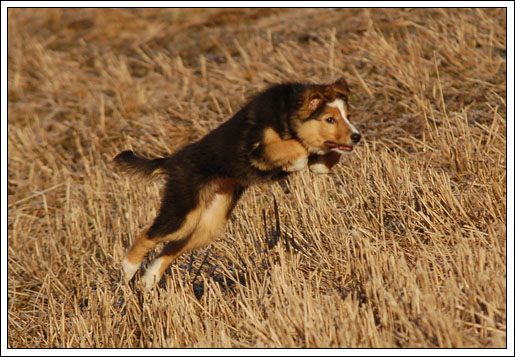
Squid, 14 weeks old
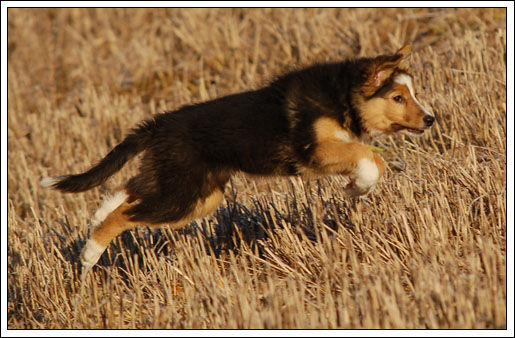
Getting faster and faster
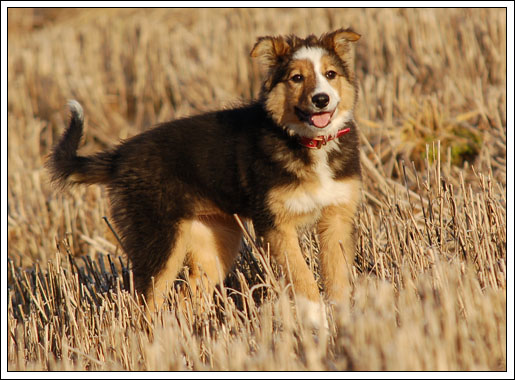
Crazy ears
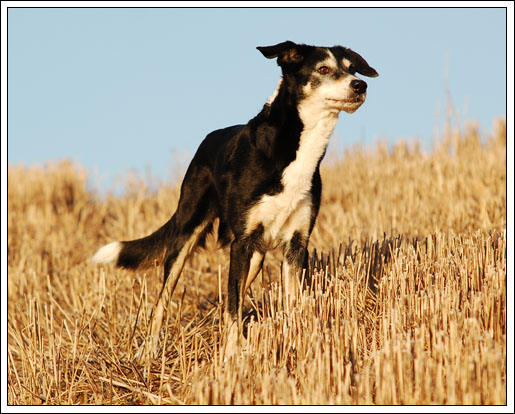
My old dog, Twiggy, lives with my parents and came to visit for Christmas
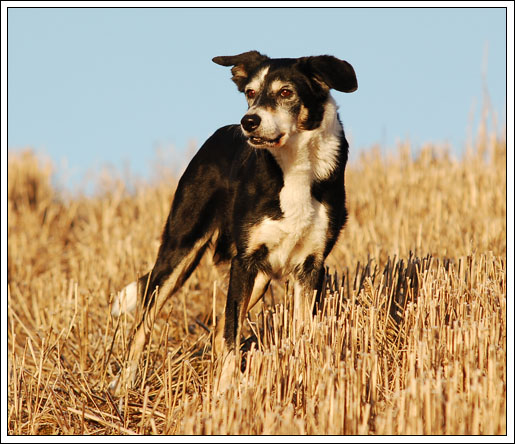
She’ll be 12 years old in March
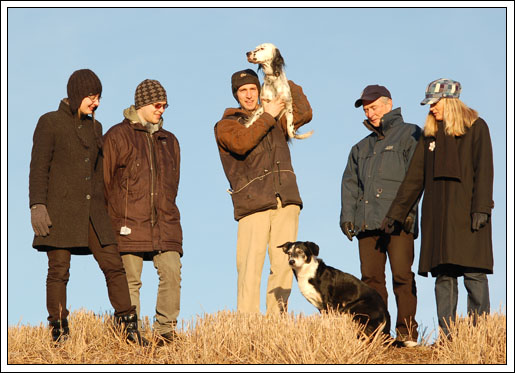
My brother and his girlfriend, Thomas with Pi and my parents with Twiggy
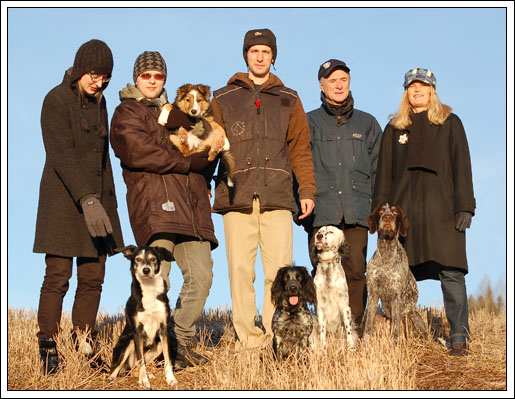
The whole gang
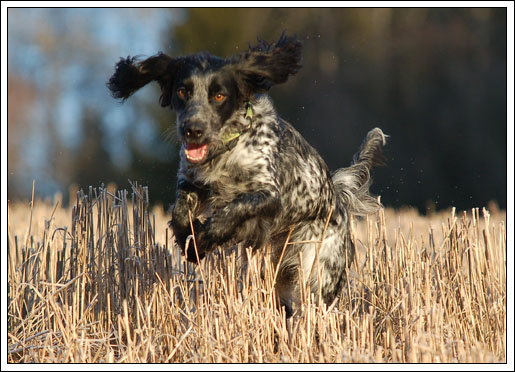
Shejpa in action
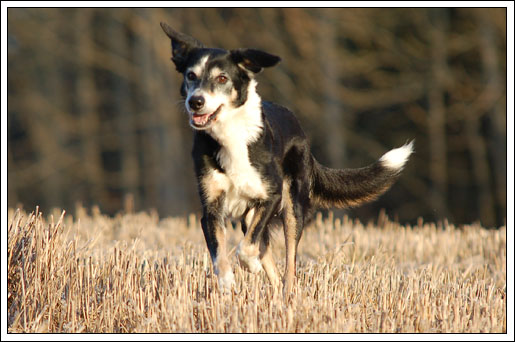
Twiggy
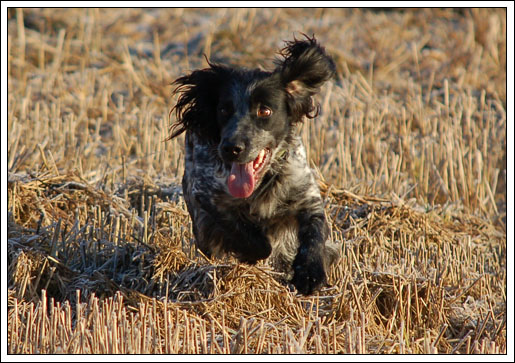
Flying cocker
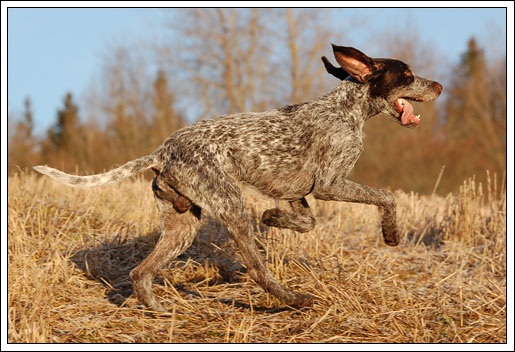
Pax really does look like a kangaroo
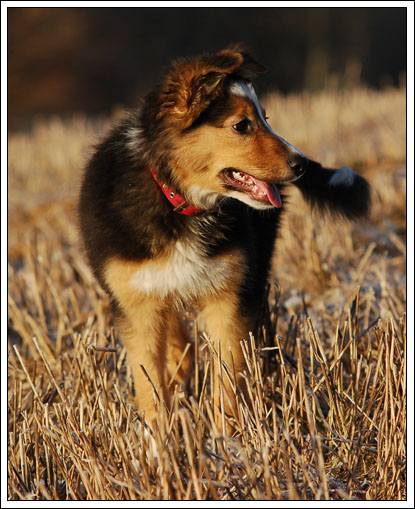
Everybody thinks she looks like a rough collie…
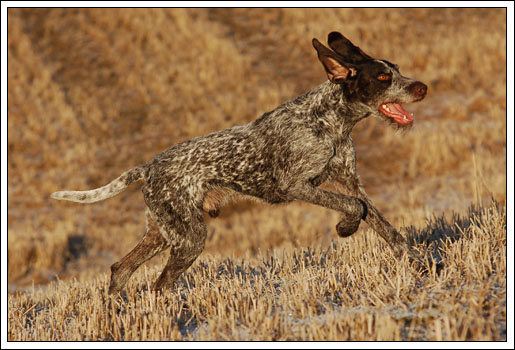
Pax, with the biggest ears in the pack
Merry Christmas! Here are some christmas gifts from us. Two videos from todays training (yes, we did some training today, even though christmas eve is the big celebration here.
Puppy Squid learning to heel
Training the moving stand with Squid
Have a wonderful christmas! We sure do
Fanny,
Thanks for taking the time to post this, I am just beginning to prepare my border collie for obedience and haven’t taught him heel. How many sessions do you usually spend walking backwards? I realize that it varies by dog, but I have a tendency to raise criteria too fast so it would be nice to have a guideline to slow me down. Do you treat while moving at your left side, stop to treat, or do you throw the treat on the ground and wait for the dog to return to position?
Robin
Hi Robin,
It’s really hard to tell how many sessions is necessary. With a dog that is used to training (and likes it), but has no previous learning of heeling AND with a good trainer, it’s a pretty fast process. I usually get all three components with a puppy in the first session. On the other hand, I have students that have to struggle with some element of it for a lot longer. Let the dog be your guide! When you love his attention, move to attitude, when you love his attitude, move on to position. When he has great attention, attitude and position – do duration!
You might get it all in a few short sessions and then decide to start turning around and rewaring correct position in the right direction. But you might then decide to go back and only work on focus while you walk backwards in an environment that is distracting for your young dog. So with a puppy, I can work on different stages depending on the level of distractions. I will turn around and walk forward when everything feels perfect in a session.
I reward the dog from my left hand, at my side, in the position where I want the dog to be, or slightly beyond. I keep walking and let the dog drive to me to get the food. Only exception is for a dog that is too high, bumping into me and charging ahead even when I walk backwards. Then I will stop and feed. Biggest problem people get is that the dog isn’t coming close enough and that comes from 1) teaching eye contact (dog can’t look you in the eyes and be in the correct position at the same time – I never teach my dogs to look at my face, but they have excellent attention anyway) or 2) Stopping and rewarding and reaching to the dog to reward instead of having dog drive into position to get the reward.
Fanny
In todays blog, I will try to describe how I train heeling for obedience trials with my puppies. There are many ways to do it, described in books and on websites. What I mostly don’t like about them is that they focus on areas that always come very easy for me, and pretty much ignores the areas that I find harder. My dogs like to to obedience with me, and if they didn’t, I wouldn’t be teaching them to heel. I would be playing tug with them and have them give me attention to get the tugging to start again, I would be doing lots of shaping games, I would be evaluating how well I have taught my dog to enjoy the rewards that I’m using. Getting them to enjoy heeling is not a problem. Having perfect position for a four minute heeling pattern is a much bigger problem. Having a dog that never swings her butt out, charges ahead (even the slightest) or changes the position of her head is the goal of my heelwork training. The clicker recipies for heeling that I have read (in english) has position as it’s least concern. They are more concerned about not having dogs that start to lag or looses focus.
With a puppy or new dog, I am however, going to teach focus and the right attitude before I am concerned about position. That should, however, be done very quickly with a dog that likes training if it hasn’t got any previous bad training in heeling or obedience in general. I also make sure that I work on focus and attitude in a setting that differs from the end goal. To do that, I walk backwards and have the dog follow me in heel position until I absolutely love my dog’s focus, attitude and position.
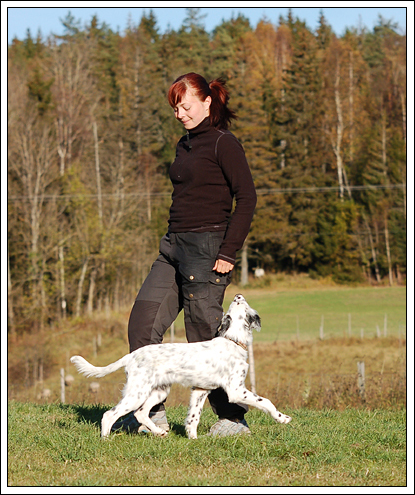
This is Pi at four months, with perfect focus, attitude and position as I walk backwards
Reasons for walking backwards in the initial stages of training heelwork:
When I start this training, I have four stages. It is important to not expect everything at once. Since we’re walking backwards, it is ok for the dog to not be perfect when we start. These are the four stages:
About rewarding
I prefer to not have treats in my hands when I train heeling. I would only do it to proof the dogs understanding of position, and for the first times when I go from backing up to forward walking. There is no need to have treats in your hand when you teach heeling if there isn’t a specific issue that you need to fix by rewarding really fast. I sometimes have treats in my right hand to be able to reward faster (I pass them behind my back and always reward with my left hand). I don’t think you should have rewards in your left hand since that will most likely make the dog too focused on the treats and/or dependent on the food as a lure.
I keep the treats in my pocket (preferably on the left side) and try to walk as much like I would at a competition as possible (not counting the fact that I am walking backwards…). I will not jog or run, but keep a steady pace with long strides. When I mark good behavior, I loosen up, praise the dog and increase speed (at least if the dog needs more attitude). At the same time, I will get a treat from my pocket with my left hand and let the dog drive to the treat at my left side (where I want dog to be, or slightly beyond). The only time I would stop and reward is for the dog who needs to calm down and who has good position allready. With good placement of reward already when working on focus, both attitude and position will often come without much work. Also consider how straight your dog is when you are rewarding. You don’t want the dog to swing his butt out when you are rewarding. If you keep moving, it’s often easier to get the dog straight.
Turning around
When the dog is doing nice heeling for 15-20 steps as you walk backwards, you can start to turn around and get the same behavior with the final cue (you walking forward and looking serious). Only turn around when your dog is doing his very best. Go back to backwards walking after each repetition of turning around in the begining. I prefer to take one step to the right and then walk forward. You can also turn to your right 180 degrees to go from backing to walking forward. Choose what works for you and your dog.
Reward your dog immediatly when he gets into the right position. If he doesn’t, break it off and try again. I don’t care about my puppy’s attitude when I do this, head might come down, but I will still reward perfect position as I turn around. Focus and attitude will come back soon! After many rewards for coming to the right position at your side, you can start to add more steps. Be very aware of the placement of reinforcement. You want the dog to always get rewarded in the correct position, without swinging his butt out. It usually helps if the dog has good rear end awareness and good finishes before you turn around.
There is of course more to heeling than this, but this should get you an idea of how to get started. I will try to make a video of my puppy doing this kind of training. Please make a comment if you have any questions.
It’s really a depressing time of year. I did wish for the snow to go away, and I guess I got what I wished for. It’s windy, dark, rainy and the road to our house is covered in ice with water on top. I have had to park the car by the postbox since it’s impossible to drive up to the house right now. I have caught a cold and is coughing constantly. Thomas is in Bergen again, working on his master thesis. Indoor training yesterday was cancelled, I guess because many of my friends have exams today. Indoor training tonight might be hard to get to, because of the icy road to the riding facility (a friend of mine got stuck on that road on Tuesday and it took us a good halv hour to get out of there). Maybe I can start training on my field again now that the snow is gone, but I have a feeling that it’s too wet and slippery.
Ok, enough of the whining. We’re soon heading for spring! Puppy Squid is now 13 weeks old and huge! She weighed 8,4 kg yesterday. She is very coordinated and has full control over her body, so it doesn’t concern me. I don’t think she’ll be a big border collie, she’s just a big puppy and has always been (like the rest of her litter), but her parents are normal size border collies. She is so far all that I wanted from a puppy. I wanted a social puppy with lots of confidence and no fears. She is all that. She loves people, especially children. She is not afraid of anything and can relax anywhere. I also wanted a puppy with a lot of brain. I want a dog with an open mind who can be thoughtful in drive and never loose her head. Her parents had the qualities I was looking for and I think she got them too.
It’s extremely easy to change her behavior. If she shows a behavior that I don’t like, it’s usually enough with a few reinforcements for good behavior and then she never looks back. She started to show interest in other dogs running agility or tugging at an early age. She would kick and scream when she saw even the slowest dog run around an agility course. I started rewarding calm behavior right away and it took me just a few repetitions to have a completely different puppy. She can stay in an open crate and be totally relaxed as other dogs run and play.
She loves food and she loves to tug and her openness to change makes it really easy to train her, she will just accept any reward from me without thinking twice about it. She loves to climb things, I had to rescue her from the seesaw already on the first day. I have some balance toys that she just loves to climb on her own and she will climb the peanut ball and use it as a resting place 😀 We had a jumping seminar here this weekend and she got to do her first puppy grid, wich she did nicely.
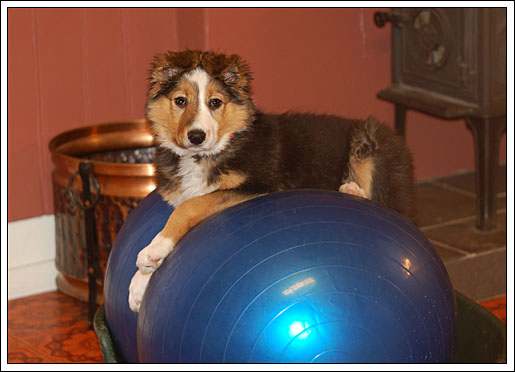
Time to go out for a walk with the dogs. I was waiting for daylight to come, but I don’t think it will get much brighter than this on a rainy and windy day like this.
We’re back from more than three days with Greg Derrett in Malmö, Sweden. It’s so much fun and the fact that I probably won’t be able to work with Greg until next December is pretty depressing. We’ll try to get some other intructors to come before that. Monday night was a lecture on the system. It’s always great to hear it again and to hear the new stuff that is going on in the system. And to be able to ask all the theoretical questions we’re always coming up with…
Tuesday started with some ground work. I ran Missy, to show that her circle work actually is pretty perfect even though it doesn’t always look like that on equipment… It was really good. We then did some two jump drills and my dogs were really showing off their worst sides. Missy was crazy and bar-dropping. Shejpa was sniffing and shutting down after a few runs. Some of it was probably my fault, it’s just like Shejpa’s first trial. I love running agility under pressure so much that I get too excited. I want to run fast, get to positional cue as fast as I can and I’m not patient enough on my rear crosses. I alternated wich dog I ran. On Wednesday, we did sequences with jumps and a tunnel. I ran Missy some in the beginning, and it was really better when I tried to think about being calm and just flowing instead of rushing. I have no problem getting where I need to be even if I’m not running away from my dogs. She was still dropping quite a lot of bars. Some of it is handler error, some of it is that Missy can’t handle my acceleration. Greg told me to do a lot of speed circles with 90 degree turns with her. Shejpa was a lot better and I ran her all afternoon. Greg concluded that: “She does have her moments of brilliance”.
We finished yesterday with a test on contacts and weaves. I was a bit nervous to try our running contacts on new equipment and under pressure, but Shejpa was just perfect. The proofing test we did on the dogwalk was stopping half way and she hit her contact below the last slat. A-frame is never a problem, so I didn’t worry about that. Seesaw is definatly a problem at times, but with just that one obstacle, she was alright and Greg was pleased. Weaves were good, Shejpa was the only dog that passed all the tests on weaves, and her time was much better than I thought it would be. We get a lot of nice comments on our weaves, but I’m not entirely pleased with them, so the plan is to retrain her with 2×2 (but I’ve said that for a long time…). 2×2 is a brilliant method and Thomas dog Pavlov has the best weaves with almost no training and he’s the only dog that has been taught with the 2x2s.
Today was about running courses, and I ran Shejpa all day (we only got through three courses). She was even better today and when she is focused and running, she really is brilliant. I think she could still get a lot more speed, but I do struggle to keep up with her sometimes, so I think she’s pretty ok. She had better turns than I thought she’d have and she is very responsive to my handling. First course was the individual small standard course from world cup (as it is on paper, not the actual course that you can watch on YouTube, they differ a lot). Shejpa was great and I manages to get us around the course fine (rewarding her seesaw). I got into position for front cross after the dogwalk and was even able to decel and be stationary and front cross as she met criteria. Contact was perfect. Next course was a pretty tricky jumpers course that was fine, apart from some footwork on my part. And the last course (wich, surprisingly enought also was a USDAA masters course!) was really easy and all about running.
Here’s a video with Shejpa running all three courses with Greg’s comments in the background.
About my handling then… I seem to have good footwork, good timing and I can run pretty fast. Most of my mistakes comes from not having enough patience. I need to work a lot more on handling with both dogs, really getting to the point of “meditation in motion” that Greg was talking about. Where you just flow around the course and also really know your dog. Missy needs a lot of work on speed circles and double box. Both dogs need to drive better to a jump before a rear cross. Shejpa needs more drive on lead out pivots, I feel that she is slowing down, especially on the harder ones.